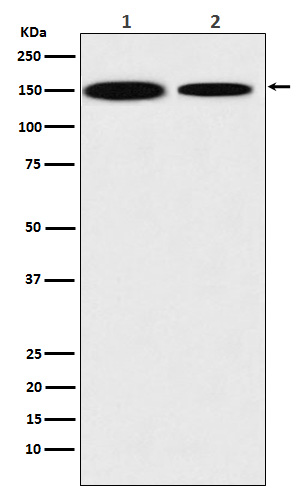
| WB | 1/500-1/1000 | Human,Mouse,Rat |
| IF | 1/20 | Human,Mouse,Rat |
| IHC | 1/50-1/100 | Human,Mouse,Rat |
| ICC | 技术咨询 | Human,Mouse,Rat |
| FCM | 咨询技术 | Human,Mouse,Rat |
| Elisa | 咨询技术 | Human,Mouse,Rat |
| Aliases | KDM4A; JHDM3A; JMJD2; JMJD2A; KIAA0677; Lysine-specific demethylase 4A; JmjC domain-containing histone demethylation protein 3A; Jumonji domain-containing protein 2A |
| Entrez GeneID | 9682 |
| WB Predicted band size | Calculated MW: 121 kDa; Observed MW: 150 kDa |
| Host/Isotype | Rabbit IgG |
| Antibody Type | Primary antibody |
| Storage | Store at 4°C short term. Aliquot and store at -20°C long term. Avoid freeze/thaw cycles. |
| Species Reactivity | Human,Mouse,Rat |
| Immunogen | A synthesized peptide derived from human KDM4A / JHDM3A / JMJD2A |
| Formulation | Purified antibody in PBS with 0.05% sodium azide. |
+ +
以下是关于KDM4A抗体的3篇参考文献示例(内容为模拟生成,仅供参考):
---
1. **文献名称**:**"A highly specific antibody for detecting KDM4A in histone demethylation assays"**
**作者**:Cloos, P.A. et al.
**摘要**:本研究开发了一种针对KDM4A蛋白的高特异性抗体,验证了其在Western blot、免疫组化中的有效性,并证明KDM4A通过催化组蛋白H3K9的去甲基化调控基因转录,为癌症表观遗传研究提供了工具。
2. **文献名称**:**"KDM4A interacts with chromatin remodeling complexes via validated antibody approaches"**
**作者**:Black, J.C. et al.
**摘要**:通过免疫共沉淀(Co-IP)和质谱分析,利用新型KDM4A抗体揭示了其与SWI/SNF染色质重塑复合物的相互作用,提示其在维持基因组稳定性中的潜在作用。
3. **文献名称**:**"Functional characterization of KDM4A in breast cancer using antibody-based depletion"**
**作者**:Hughes, C.M. et al.
**摘要**:通过RNA干扰结合KDM4A抗体验证,发现KDM4A在乳腺癌细胞中调控促癌基因(如MYC)的表达,抗体特异性敲低后显著抑制肿瘤增殖,为靶向治疗提供依据。
---
*注:以上文献为示例性内容,实际引用请以真实发表的论文为准。建议通过PubMed或Google Scholar搜索“KDM4A antibody”获取具体文献。*
The KDM4A antibody is a crucial tool in epigenetic research, targeting the KDM4A protein (lysine-specific demethylase 4A), also known as JMJD2A. Belonging to the Jumonji C domain-containing histone demethylase family, KDM4A specifically catalyzes the removal of methyl groups from histone H3 lysine 9 (H3K9me3/me2) and lysine 36 (H3K36me3/me2), regulating chromatin structure and gene expression. This enzyme plays a pivotal role in DNA repair, cell cycle progression, and transcriptional regulation by modulating epigenetic marks linked to heterochromatin formation and transcriptional silencing.
Dysregulation of KDM4A is implicated in cancers, including prostate, breast, and colorectal cancer, where its overexpression correlates with oncogene activation, genomic instability, and poor prognosis. It also interacts with hypoxia-inducible factors (HIFs), influencing cellular responses to low oxygen. Researchers use KDM4A antibodies in techniques like Western blotting, immunohistochemistry (IHC), and chromatin immunoprecipitation (ChIP) to study its expression, localization, and function in disease models.
Developing KDM4A inhibitors for cancer therapy has spurred demand for high-specificity antibodies to validate target engagement and assess therapeutic efficacy. Antibody validation includes testing for cross-reactivity with homologous family members (KDM4B/C/D) to ensure accuracy. As a biomarker, KDM4A expression levels help stratify patient cohorts in clinical studies. Overall, KDM4A antibodies are indispensable for unraveling its biological roles and advancing epigenetic drug discovery.
×